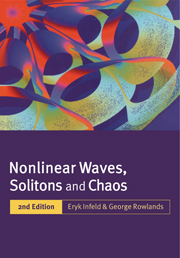Book contents
- Frontmatter
- Contents
- Foreword to the first edition
- Foreword to the second edition
- 1 Introduction
- 2 Linear waves and instabilities in infinite media
- 3 Convective and non-convective instabilities; group velocity in unstable media
- 4 A first look at surface waves and instabilities
- 5 Model equations for small amplitude waves and solitons; weakly nonlinear theory
- 6 Exact methods for fully nonlinear waves and solitons
- 7 Cartesian solitons in one and two space dimensions
- 8 Evolution and stability of initially one-dimensional waves and solitons
- 9 Cylindrical and spherical solitons in plasmas and other media
- 10 Soliton metamorphosis
- 11 Non-coherent phenomena
- Appendices
- References
- Author index
- Subject index
- Plate section
Foreword to the first edition
Published online by Cambridge University Press: 05 June 2012
- Frontmatter
- Contents
- Foreword to the first edition
- Foreword to the second edition
- 1 Introduction
- 2 Linear waves and instabilities in infinite media
- 3 Convective and non-convective instabilities; group velocity in unstable media
- 4 A first look at surface waves and instabilities
- 5 Model equations for small amplitude waves and solitons; weakly nonlinear theory
- 6 Exact methods for fully nonlinear waves and solitons
- 7 Cartesian solitons in one and two space dimensions
- 8 Evolution and stability of initially one-dimensional waves and solitons
- 9 Cylindrical and spherical solitons in plasmas and other media
- 10 Soliton metamorphosis
- 11 Non-coherent phenomena
- Appendices
- References
- Author index
- Subject index
- Plate section
Summary
The last few decades have seen three important developments in nonlinear classical physics, all of which extend across the board of physical disciplines. They have, however, received uneven coverage in the literature.
Perhaps the best known outburst of activity is associated with the soliton, and the most famous development here is the inverse scattering method which has been with us now for over twenty years. There are, however, several other, less known methods for treating solitons. Indeed these compact, single hump wave entities have been known to scientists for over a century and a half (it might be interesting to look through some old ships' log books!). Nevertheless, books on the subject tend to concentrate on the inverse scattering method.
The second much publicized development is a new understanding of some deterministic aspects of chaos as well as the various roads a physical system can take to reach a chaotic state. Established views are being revised and new concepts and indeed even universal constants are being found. These important new developments derive from a realization that complex chaotic behaviour can be described by simple equations. The field has now reached the stage where a summary of basic theory can be given, though applications to specific physical problems are largely at the research stage.
The third development is somewhat less well publicized. Over the last three decades or so, scientists working on fluid dynamics and plasma and solid state theory have developed a multitude of new methods to deal with nonlinear waves.
- Type
- Chapter
- Information
- Nonlinear Waves, Solitons and Chaos , pp. xi - xiiPublisher: Cambridge University PressPrint publication year: 2000



